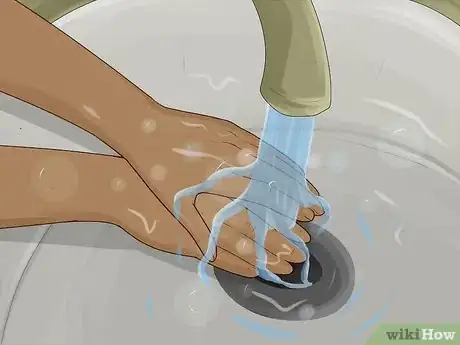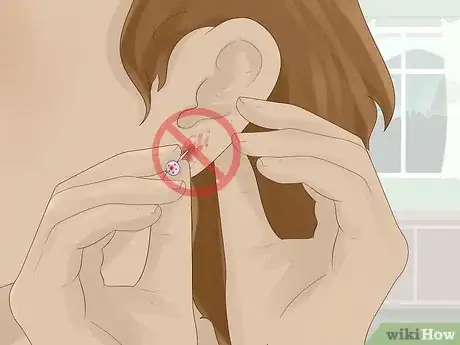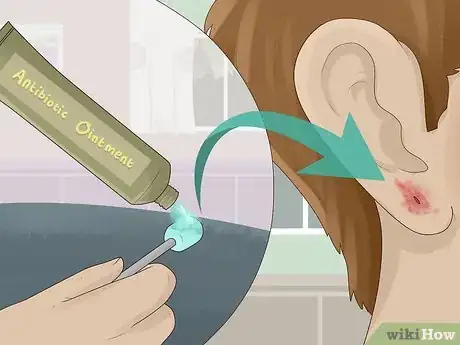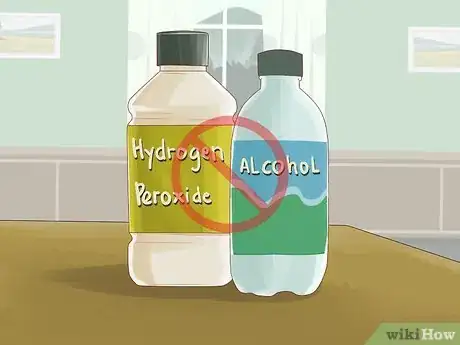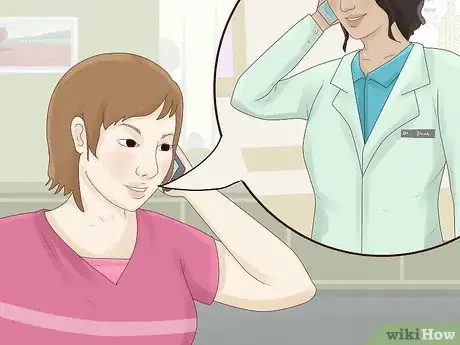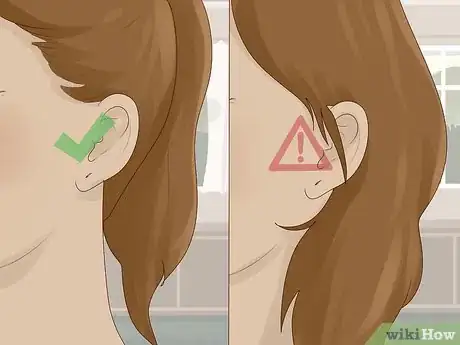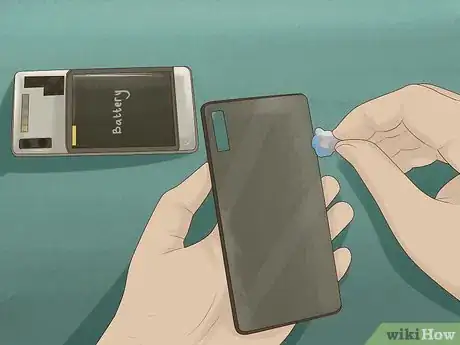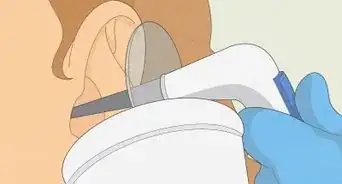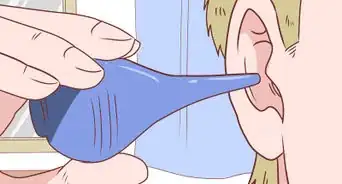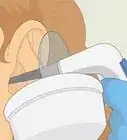This article was co-authored by Navid Malakouti, MD, FAAD. Dr. Navid Malakouti is a Board Certified Dermatologist specializing in cosmetic dermatology, dermatologic surgery, and medical dermatology. He treats patients of all ages for conditions like acne, rosacea, psoriasis, skin cancer, botox, fillers, lasers, and chemical peel. Dr. Malakouti is a Diplomate of the American Board of Dermatology, Fellow of American Academy of Dermatology, American Society for Dermatologic Surgery, and American Society for Laser Medicine and Surgery, and a member of the Skin of Color Society. He holds a BS in Biochemistry and Cell Biology from The University of California, San Diego and an MD from The Virginia Commonwealth University School of Medicine. He completed his Dermatology residency in Washington D.C. at Howard University, VA Medical Center, Children's National Hospital, and the National Institutes of Health.
There are 12 references cited in this article, which can be found at the bottom of the page.
This article has been viewed 185,399 times.
Infected ear piercings are common, especially in new piercings. Most go away after one to two weeks, as long you clean them twice a day. Use a cotton ball or swab soaked in a saline solution or antimicrobial soap to clean the infection, then dry the area with a disposable paper towel. Avoid using alcohol and hydrogen peroxide, as these substances will interfere with healing. See your doctor if the infection spreads, if it doesn't improve within two days, or if you develop a fever. Always wash your hands before touching your piercings, and prevent reinfecting the area by avoiding swimming and sanitizing your cell phone.
Steps
Cleaning an Infected Piercing at Home
-
1Wash your hands before touching the piercing. Always wash your hands well before touching a piercing, especially if it’s new or infected. Use an antimicrobial soap and warm water. Avoid fiddling with your earrings and only touch them when you have to clean them.[1]
-
2Do not remove a new ear piercing. If your piercing is new, keep it in place for at least six weeks, even if it becomes infected. While you should rotate a new lobe piercing, stop rotating it if it becomes infected for one to two weeks.[2]
- If your infected piercing is permanent, or more than six months old, remove the earring while you deal with the infection.
Advertisement -
3Clean the piercing with a cotton ball dipped in saline or soap. Soak a cotton ball or swab in saline solution or a mild antimicrobial soap. Dab the soaked ball or swab around the infected area. Then dry the area with disposable paper towels.[3]
- If the shop where you got your ear pierced provided a saline solution, use it to clean your ears. You can also purchase a pre-made product or make a saline solution by mixing 2 teaspoons of salt with a quart (about a liter) of warm water.
- If you use a soap, go with a fragrance free brand that doesn’t contain alcohol.
- Clean an infected ear piercing twice a day. You can rotate the earrings during this time while they are still wet from the saline solution or soap.
-
4Apply an antibiotic ointment. After cleaning and drying the piercing, you can apply an antibacterial ointment to encourage healing. Dab a small amount of the ointment onto a cotton swab and paint a thin coating over the infected area.[4] [5]
- If the infection is weeping or emitting a discharge, avoid using ointment.[6]
-
5Avoid rubbing alcohol and hydrogen peroxide. Rubbing alcohol and hydrogen peroxide will dry out the infected area and kill cells that are needed for healing. Killing white blood cells around the infected site could make the infection even worse. Don’t apply alcohol or hydrogen peroxide to the infection, and make sure any cleaning products you use are alcohol free.[7]
Seeing a Medical Professional
-
1Contact your doctor if the infection doesn’t improve after two days. Start by cleaning the infection twice a day at home. You should see signs of improvement, like reduced redness or swelling, after two days. If the infection worsens or shows no signs of improvement, schedule an appointment with your doctor or visit a healthcare clinic.[8] [9]
-
2See a doctor if the infection spreads or if you develop a fever. Monitor the infection closely during the first day. See a doctor if the infection starts spreading beyond the piercing site or if you develop a fever. These could indicate a more serious infection that will require antibiotic treatment.[10] [11]
-
3Have a doctor examine an infected cartilage piercing. Be extra cautious about dealing with an infected cartilage piercing, or a piercing at the top part of the ear. It’s better to be on the safe side and have a doctor look at infected cartilage sooner rather than later. Infected cartilage piercings are more likely to escalate, and they can lead to long-term deformities, such as "cauliflower ear," which causes the cartilage to take on a bumpy appearance.[12]
-
4Talk to the doctor about getting antibiotics. When you visit your doctor, they’ll likely take a culture of the infection site. This will help them identify the type of bacteria that has caused the infection.[13]
- Ask the doctor, “Do you recommend any antibiotics for this infection? What type of antibiotic is most effective for this type of bacterial infection?”[14]
- Do not wash or clean the piercing for at least 24 hours before seeing a doctor. The doctor will want to take a swab of the infected ear to diagnose it, and cleaning products can interfere with this test.
-
5Ask for an allergy test. Redness, swelling, itchiness, and other signs of infection can also be due to an allergy. If cultures come back negative, talk to your doctor about getting an allergy test.[15]
- If you’ve never had a piercing before, you might find that you have a metal allergy. You can avoid allergic reactions to piercings by getting an earring that is nickel-free, as nickel is the most common metallic allergen.
- Your doctor may refer you to an allergist for more specialized testing to identify what the allergy might be.
Preventing Reinfection
-
1Avoid swimming after getting a new piercing. Always avoid swimming for at least two weeks after getting a new piercing.[16] Stay away from pools, lakes, and ocean water during that time, and clean the piercing with saline solution after taking a shower.[17]
- You should also avoid swimming while treating an infected permanent piercing.
-
2Keep hair away from the ear piercing. If you have long hair, tie it back to keep it away from a new or infected piercing. Wash your hair more often than you ordinarily would.[18]
- Take care not to get hairspray or gel in the piercing or to snag it when brushing your hair.
-
3Disinfect your cell phone daily. Cell phones are covered with bacteria that can cause infections, so you should regularly disinfect your phone even if you’re not dealing with an infected piercing. Remove your phone’s case and clean both the case and the phone using a disinfecting wipe or paper towel sprayed with a cleaning solution.[19]
- You should also sanitize any other phones you use.
- You can also put your phone on speaker when people call. This will minimize how much you touch your ear.
-
4Sleep without earrings after the piercings become permanent. If your piercing is new, you should keep your first post in for six weeks and wear an earring at all times for six months. After six months, your piercing will become permanent. Once it’s permanent, you should take your earrings out at night to expose the channels to air and prevent infection.[20]
-
5Visit reputable clinics for new piercings. The cleaner the clinic you visit, the less likely your new piercing will become infected. Read reviews on piercing clinics and parlors before visiting. Make sure that the parlor is licensed. When you go to get a new ear piercing, watch to see that the staff wears latex gloves and ask if they have the proper machinery for sterilizing their equipment.[21]
- It is not a good idea to get pierced at night markets or abroad while on vacation.
- You should not have a friend pierce your ears for you at home, as they will not be able to properly sterilize their equipment.
Expert Q&A
-
QuestionIs my piercing infected or just healing?
 Navid Malakouti, MD, FAADDr. Navid Malakouti is a Board Certified Dermatologist specializing in cosmetic dermatology, dermatologic surgery, and medical dermatology. He treats patients of all ages for conditions like acne, rosacea, psoriasis, skin cancer, botox, fillers, lasers, and chemical peel. Dr. Malakouti is a Diplomate of the American Board of Dermatology, Fellow of American Academy of Dermatology, American Society for Dermatologic Surgery, and American Society for Laser Medicine and Surgery, and a member of the Skin of Color Society. He holds a BS in Biochemistry and Cell Biology from The University of California, San Diego and an MD from The Virginia Commonwealth University School of Medicine. He completed his Dermatology residency in Washington D.C. at Howard University, VA Medical Center, Children's National Hospital, and the National Institutes of Health.
Navid Malakouti, MD, FAADDr. Navid Malakouti is a Board Certified Dermatologist specializing in cosmetic dermatology, dermatologic surgery, and medical dermatology. He treats patients of all ages for conditions like acne, rosacea, psoriasis, skin cancer, botox, fillers, lasers, and chemical peel. Dr. Malakouti is a Diplomate of the American Board of Dermatology, Fellow of American Academy of Dermatology, American Society for Dermatologic Surgery, and American Society for Laser Medicine and Surgery, and a member of the Skin of Color Society. He holds a BS in Biochemistry and Cell Biology from The University of California, San Diego and an MD from The Virginia Commonwealth University School of Medicine. He completed his Dermatology residency in Washington D.C. at Howard University, VA Medical Center, Children's National Hospital, and the National Institutes of Health.
Board Certified Dermatologist Some of the infection symptoms (pain, redness, swelling and warmth in the are) will be present as a result of the piercing within the first 24 hours, but this does not mean it is infected. If symptoms persist for more than 48 hours after piercing, though, it is important to be evaluated by a physician.
Some of the infection symptoms (pain, redness, swelling and warmth in the are) will be present as a result of the piercing within the first 24 hours, but this does not mean it is infected. If symptoms persist for more than 48 hours after piercing, though, it is important to be evaluated by a physician.
Warnings
References
- ↑ http://www.parents.com/health/ear-infection/ear-piercing-for-kids/
- ↑ http://www.newhealthguide.org/Infected-Ear-Piercing.html
- ↑ https://www.aad.org/public/everyday-care/skin-care-basics/tattoos/caring-for-pierced-ears
- ↑ Navid Malakouti, MD, FAAD. Board Certified Dermatologist. Expert Interview. 19 July 2021.
- ↑ http://www.summitmedicalgroup.com/library/pediatric_health/hhg_teen_pierced-ear/
- ↑ http://woundcaresociety.org/drain-infected-ear-piercing
- ↑ http://www.aboutkidshealth.ca/En/HealthAZ/ConditionsandDiseases/Dermatology/Pages/Pierced-Ear-Infection.aspx
- ↑ Navid Malakouti, MD, FAAD. Board Certified Dermatologist. Expert Interview. 19 July 2021.
- ↑ http://www.aboutkidshealth.ca/En/HealthAZ/ConditionsandDiseases/Dermatology/Pages/Pierced-Ear-Infection.aspx
- ↑ Navid Malakouti, MD, FAAD. Board Certified Dermatologist. Expert Interview. 19 July 2021.
- ↑ http://www.aboutkidshealth.ca/En/HealthAZ/ConditionsandDiseases/Dermatology/Pages/Pierced-Ear-Infection.aspx
- ↑ https://www.ncbi.nlm.nih.gov/pmc/articles/PMC1781501/
- ↑ https://www.ncbi.nlm.nih.gov/pmc/articles/PMC1781501/
- ↑ Navid Malakouti, MD, FAAD. Board Certified Dermatologist. Expert Interview. 19 July 2021.
- ↑ http://www.mayoclinic.org/healthy-lifestyle/adult-health/in-depth/piercings/art-20047317
- ↑ https://www.ncbi.nlm.nih.gov/pmc/articles/PMC1781501/
- ↑ http://www.newhealthguide.org/Infected-Ear-Piercing.html
- ↑ http://www.parents.com/health/ear-infection/ear-piercing-for-kids/
- ↑ http://www.summitmedicalgroup.com/library/pediatric_health/hhg_teen_pierced-ear/
- ↑ http://www.summitmedicalgroup.com/library/pediatric_health/hhg_teen_pierced-ear/
- ↑ https://www.uhs.umich.edu/bodyart
- ↑ http://www.hepatitiscentral.com/news/hepatitis-c-and-body-piercing/
- ↑ http://www.mayoclinic.org/diseases-conditions/hepatitis-c/symptoms-causes/dxc-20207369
About This Article
Before you clean your infected ear piercing, wash your hands with soap and warm water. Then, soak a cotton ball in saline solution or a mild antimicrobial soap. Gently dab the cotton ball around the infected area, and dry it with a paper towel. You can then apply some antibiotic ointment with a cotton swab, which will promote healing. If your piercing is more than 6 weeks old, you can remove your earring to clean the infected piercing. However, you should leave your earring in place if the piercing is less than 6 weeks old, even if it’s infected. For information on how to tell when your infected ear piercing warrants medical attention, read on!
